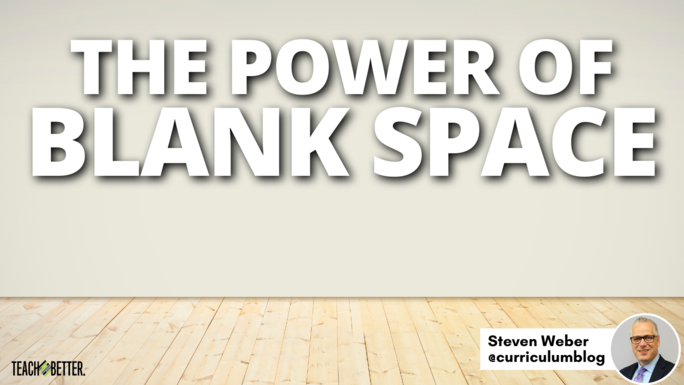TL;DR:
- Blank Space is any area that provides learners with the opportunity to practice life skills such as creativity and critical thinking.
- Consider designing your classroom with intentional blank space to invite students to actively participate in their learning.
- Some strategies could include blank whiteboards mounted around the room, window markers, or goal setting space.
Traditional Classroom Design
On the first day of school, most classrooms have educational posters, inspiring quotes, a vocabulary wall, and other prompts to support learners. Many classrooms look like a page straight out of Pinterest or Instagram, designed for aesthetics. While students benefit from anchor charts, bulletin boards, and scaffolding, one issue with traditional classroom design is a lack of student ownership.
Where is the Blank Space?
Initially, one question needs to be asked in each classroom, “Where is the Blank Space?” Teachers and curriculum design teams typically begin unit planning with the question: What should every student know and be able to do? As a result of this type of planning, teachers often design anchor charts, bell ringer activities, and assignments that provide little room for inquiry, brainstorming, and blank space.
Consider designing your classroom with intentional blank space to invite students to actively participate in their learning.
“Teachers who promote reflective classrooms ensure that students are fully engaged in the process of making meaning. They organize instruction so that students are the producers, not just the consumers, of knowledge.”
– Costa & Kallick, 2008
The most powerful thing about creating blank space in schools is that it invites students to become contributors and to think outside the box. Click To TweetWhat is Blank Space?
Blank Space is any area of the classroom, hallway, or learning space (virtual or on-site) that provides learners with the opportunity to practice life skills.
As educators discuss the curriculum priorities for a unit, most would agree that they want students to practice and develop the following skills:
- Creativity
- Critical Thinking
- Cognitive Flexibility
- Communication
- Contribution
- Decision Making
- Goal Setting
- Leadership
- Metacognition
- Organization and Planning
- Problem Solving
Designing with Blank Space
Over the past twenty-five years, I have visited schools and classrooms where the blank space was intentionally planned. One teacher purchased mini whiteboards and hung them at eye level for students to brainstorm and create their projects. Another teacher placed Post-it Notes on the wall for students to collaborate.
The following strategies may support Blank Space in your school:
- Allow students to write on the windows
- Blank bulletin board
- Create a corner of the room called the Innovation Station
- Provide materials for brainstorming and inquiry
- Create a Makerspace in your classroom or school library
- Create videos
- Google Docs
- Google Jamboard
- Graffiti Board is a popular strategy for student voice; hang large paper on a wall or drape across a table
- Hang dry-erase boards in the hallway
- Have a Question of the Day; allow students to post their answer to the Question of the Day
- Leave a white space on the wall for students to collaborate
- Padlet
- Journals
- Outdoor learning space
- Personal goal setting
- Provide students with the opportunity to use clay, paint, or other art supplies and provide space to create
- Provide time for reflection
- Quick Write
- Use an S-Hook to hang a mini whiteboard and towel on each desk
- Use the students’ desks as a place to write and plan projects
A “Thinking Curriculum calls for a recognition that all real learning involves thinking, that thinking ability can be nurtured and cultivated in everyone, and that the entire educational program must be reconceived and revitalized so that thinking pervades students’ lives from kindergarten onward” (Resnick & Klopfer, 1989). While most teachers have good intentions when they design their classroom, it would be wise to reflect upon the definition of a thinking classroom.
Reflection
Finally, let’s take a look at your own learning environment. As you look around the classroom, have you left any blank space for students to practice creativity, critical thinking, goal setting, and planning? What small changes can you make to build in more Blank Space?
Perhaps the most powerful thing about creating blank space in schools is that it invites students to become contributors and to think outside the box. If students are going to learn important life skills, then teachers and staff need to intentionally create more blank space for learners.
“If our goal is to support students in becoming self-directed, independent and interdependent, then we must provide a learning environment that supports them in doing so.”
– Shaw, 2017
About Steven Weber
Dr. Steven Weber is the Associate Superintendent for Teaching and Learning with Fayetteville Public Schools (AR). His areas of research include curriculum design, formative assessment, professional learning, and school leadership.




